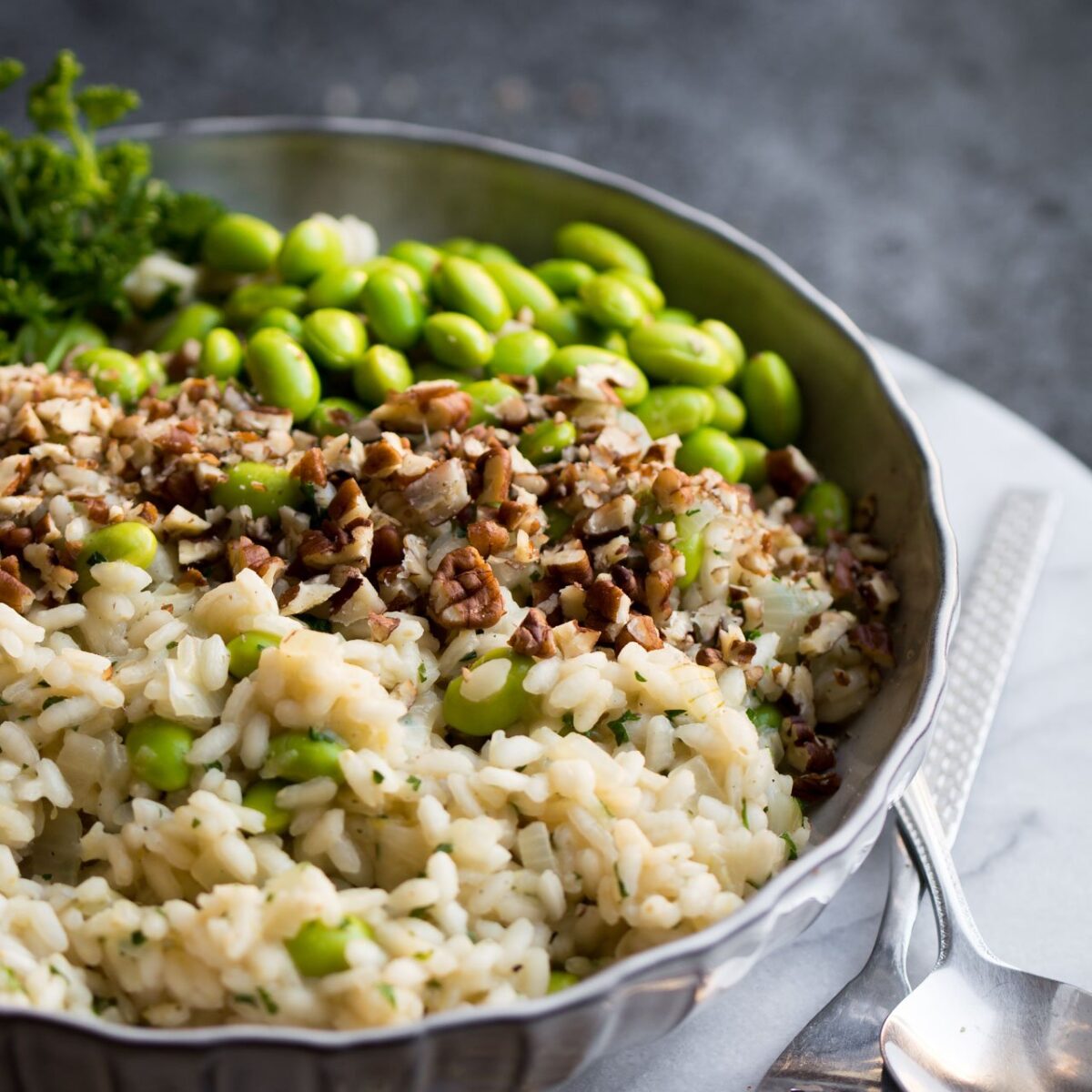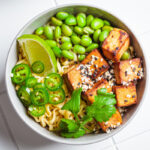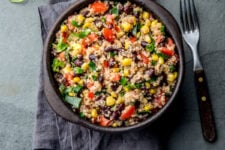What comes to your mind when you think of high-protein foods? For many people, the answer to that question is meat.
However, there are lots of other foods that are good sources of protein, including many plants. In fact, the Dietary Guidelines for Americans recommends a diet rich in plant-based proteins, like beans, peas, nuts, and lentils (1).
If you follow a vegetarian or vegan diet, you may wonder if you are eating enough protein. The good news is that many vegetables are good sources of protein.
Learn more about the highest protein vegetables and how to incorporate them into your diet below.

Why is Protein Important?
Protein is a macronutrient made up of amino acids and has many essential functions in the body. For example, different proteins play a role in maintaining healthy muscles, bones, and skin (2).
We’ve all heard that eating enough protein is important, especially in a plant-based diet. However, many people think they need more protein than they actually do.
An average person needs around 7 grams of protein per 20 pounds of body weight (2). For example, a person weighing 180 lbs would need about 65 grams of protein daily.
It’s not just about how much total protein you are eating; the types of protein in your diet matter. Eating a variety of plant proteins has been shown to reduce the risk of heart disease, type 2 diabetes, and cancer (2).
Getting the right balance of essential amino acids is also important. These are the building blocks of proteins that we must get from foods. Eating a wide variety of protein sources will ensure you get what you need (2).
Top 12 High Protein Vegetables
How do you boost your protein intake with vegetables? Below is a list of the highest protein vegetables ranked from highest to lowest.
Keep in mind, there are other plant sources of protein that are not classified as vegetables, such as nuts, seeds, and whole grains. A balanced diet includes a variety of these food groups to meet your protein needs.

1. Edamame
9.2 grams of protein in ½ cup, cooked.
The number one highest protein vegetable is edamame (also known as soybeans). With over 9 grams of protein per serving, these tasty beans are a plant-protein power pack (3).
Edamame is great for snacking and can be bought frozen for easy preparation. You can also find edamame as a delicious side dish at your favorite sushi restaurant.
Edamame Recipes

2. Lentils
9 grams of protein in ½ cup, cooked.
All types of lentils– brown, green, and red– are excellent plant protein sources. Lentils are also among the highest-fiber foods, and are an great source of folate (4).
Lentils, beans, and peas are all part of the legume family. Swapping red meat for legumes has numerous health benefits, particularly in reducing cancer and heart disease risk (2).
New to eating lentils? A great place to start is a hearty vegetable lentil soup. Bonus points if your recipe includes some of the other veggies on this list!
Lentil Recipes

3. Kidney beans
7.7 grams of protein in ½ cup, cooked.
Kidney beans are one of the highest protein beans, though other beans are good protein sources too. Black beans, lima beans, and navy beans all contain over 7 grams of protein per serving (5).
The most popular way to eat kidney beans is in chili. You can also try them in a marinated bean salad for a zesty side dish or snack.
Kidney Bean Recipes

4. Chickpeas
7.3 grams of protein in ½ cup, cooked.
Chickpeas, or garbanzo beans, are one of the most versatile plant proteins. Add them to a soup, top your salad with roasted chickpeas, or enjoy a snack of creamy hummus.
In addition to providing over 7 grams of protein per serving, chickpeas are also a great source of fiber and potassium (6).
Chickpea Recipes

5. Potato
4.5 grams of protein in 1 medium russet potato.
Often given a bad rap nutritionally, potatoes are actually very nutrient dense! One russet potato provides 5 grams of plant protein and a whopping 950 milligrams of potassium (7).
Try a baked potato topped with vegetarian chili for a comforting, high-protein meal.
Potato Recipes

6. Green Peas
4.3 grams of protein in ½ cup, cooked.
Green peas are an unexpected high-protein vegetable with over 4 grams of protein per serving (8). Add peas to soups or salads to boost the protein and fiber content of your meals. Peas also make a great side dish!
Green Pea Recipes

7. Avocado
4 grams of protein in 1 medium avocado.
Though avocados are known for being a good source of healthy fats, they also contain some protein, with 4 grams in one avocado (9).
You can add avocado to many meals to boost the protein content– avocado toast, guacamole, smoothies– the possibilities are endless!
Avocado Recipes

8. Spinach
3.8 grams of protein in ½ cup, cooked.
You’ve likely heard that dark leafy greens are good for you, but did you know they also have protein? Spinach has almost 4 grams of protein in a serving and is a good source of vitamin K and plant-based iron (10). In fact, Spinach is one of the healthiest vegetables you can eat.
Keep a bag of spinach on hand to easily add to meals like soup, salads, pasta, and more.
Kale is often grouped in the same nutritional category as spinach, but when it comes to protein, kale has less than half of the protein that spinach does (11).
Spinach Recipes

9. Corn
3.5 grams of protein in 1 medium ear of sweet corn.
Interestingly, sweet yellow corn provides some protein along with being a delicious summer side dish. One ear of corn has 3.5 grams of plant-based protein (12).
Corn Recipes

10. Artichokes
2.4 grams of protein in ½ cup, cooked.
Artichoke hearts contain almost 2.5 grams of protein in a serving and are a great source of soluble fiber (13).
Try a spinach artichoke dip as an appetizer or side dish to add some plant protein to your meal.
Artichoke Recipes

11. Asparagus
2.2 grams of protein in ½ cup, cooked.
Asparagus provides just over 2 grams of protein in ½ cup (14). Enjoy asparagus as a simple and versatile side dish, especially in the spring months when it’s in season.
Asparagus Recipes

12. Brussels sprouts
2 grams of protein in ½ cup, cooked.
Just half a cup of brussels sprouts contains 2 grams of plant protein (15). You’ll also reap the other benefits of eating cruciferous vegetables, like improved heart health (16).
Not a fan of brussels sprouts? Try roasting them, which reduces the bitter taste and brings out their natural sweetness.
Broccoli is in the same family as brussels sprouts and is often thought of as containing protein. However, it does not actually contain much protein, with less than 2 grams in a ½ cup serving (17).
Brussels Sprouts Recipes
12 High-Protein Vegetables
Ingredients
- Edamame
- Lentils
- Kidney Beans
- Chickpeas
- Potatoes
- Green Peas
- Avocado
- Spinach
- Corn
- Artichokes
- Asparagus
- Brussels Sprouts







